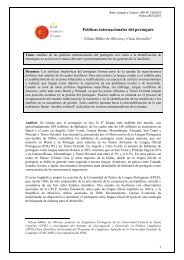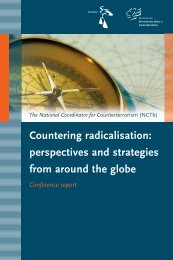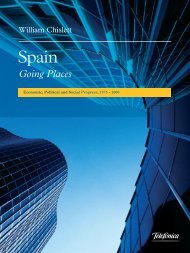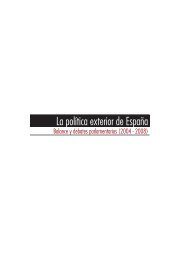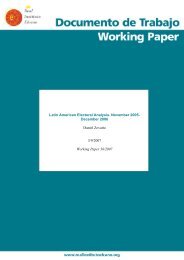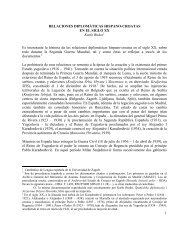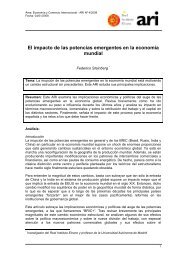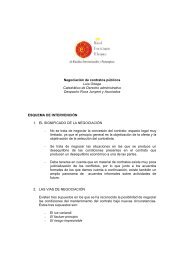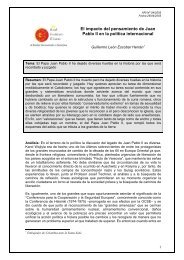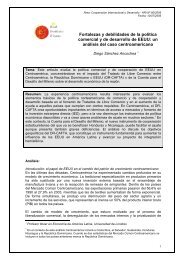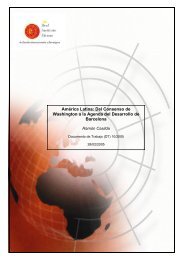Spain and the United States - Real Instituto Elcano
Spain and the United States - Real Instituto Elcano
Spain and the United States - Real Instituto Elcano
You also want an ePaper? Increase the reach of your titles
YUMPU automatically turns print PDFs into web optimized ePapers that Google loves.
114<br />
SPAIN AND THE UNITED STATES<br />
Exhibit 6.5. Fulbright Grants in Europe by Selected Countries, 1949-2003<br />
O<strong>the</strong>r institutions have created permanent links with US universities,<br />
Two private sector sponsors funded chairs at Georgetown University <strong>and</strong><br />
<strong>the</strong> University of New Mexico, <strong>and</strong> <strong>the</strong> Complutense University of<br />
Madrid established a permanent centre at Harvard University. New York<br />
University created <strong>the</strong> King Juan Carlos I of <strong>Spain</strong> Centre in 1997, probably<br />
<strong>the</strong> leading centre in <strong>the</strong> <strong>United</strong> <strong>States</strong> for <strong>the</strong> study of <strong>Spain</strong> <strong>and</strong> Latin<br />
America, which is funded by various Spanish <strong>and</strong> American companies, <strong>and</strong><br />
Harvard created an Iberian Study Centre within <strong>the</strong> Minda de Gunzburg Centre<br />
for European Studies.<br />
The Culture Ministry began a programme in 1983 to foment <strong>the</strong> spread of<br />
Spanish culture in US universities, including funds for <strong>the</strong> translation of classic<br />
literature into English, promoting films, visits by teachers <strong>and</strong> writers <strong>and</strong><br />
research on little explored areas in <strong>the</strong> sphere of Hispanism. In <strong>the</strong> first 20<br />
years of <strong>the</strong> programme <strong>the</strong> ministry contributed around $4.6 million.<br />
Internet is also playing an increasingly important role in promoting<br />
Spanish culture <strong>and</strong> linking Spanish <strong>and</strong> American university students. The<br />
Miguel Cervantes Virtual Library (www.cervantesvirtual.com), created in 1999<br />
by <strong>the</strong> University of Alicante, with <strong>the</strong> sponsorship of Grupo Sat<strong>and</strong>er <strong>and</strong> <strong>the</strong><br />
Marcelino Botín Foundation, has <strong>the</strong> largest on-line collection of Hispanic<br />
works <strong>and</strong> is <strong>the</strong> most visited Spanish literary website. The central core of <strong>the</strong><br />
library are <strong>the</strong> institutional <strong>and</strong> <strong>the</strong>matic portals. The former are <strong>the</strong> result of<br />
cooperation agreements with some of <strong>Spain</strong>’s <strong>and</strong> Latin America’s main<br />
institutions, such as <strong>the</strong> Royal Spanish Academy <strong>and</strong> <strong>the</strong> National Libraries of<br />
<strong>Spain</strong>, Brazil, Chile <strong>and</strong> Argentina. The <strong>the</strong>matic portals cover literature,<br />
history, geography <strong>and</strong> cinema. Universia (www.universia.net), created in<br />
2000 by <strong>the</strong> Conference of Spanish Universities, <strong>the</strong> Higher Council of<br />
Scientific Research, 32 Spanish universities <strong>and</strong> Grupo Sant<strong>and</strong>er, is <strong>the</strong>



